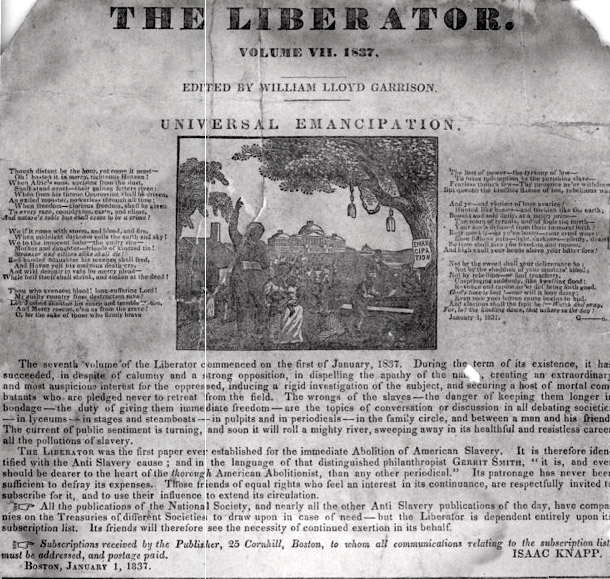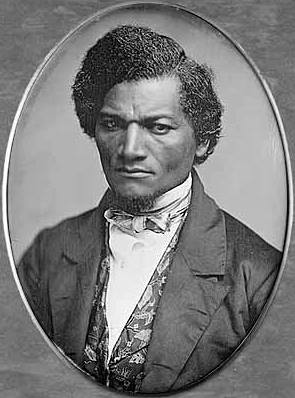Considering History: William Lloyd Garrison — An Activist Ahead of His Time
This series by American studies professor Ben Railton explores the connections between America’s past and present.
On December 10, 1805, William Lloyd Garrison (1805-1879) was born in Newburyport, Massachusetts. The son of immigrants from New Brunswick, Garrison would grow up to become one of America’s most prominent and influential journalists and abolitionists. For nearly three decades, from its 1831 founding through the end of the Civil War, his Boston-based newspaper The Liberator served as a primary medium for the anti-slavery movement.

Yet if we focus only on Garrison’s abolitionism, we miss many other key elements of his life, elements that embody his consistent support for fellow activists, particularly those in less privileged positions. Garrison was ahead of his time in modeling an impassioned, inclusive, intersectional activism that applies to our 21st century moment.
Even Garrison’s signature abolitionism was significantly more courageous and inspiring than it might seem. From the vantage point of 2019, an anti-slavery perspective might appear to have been a popular and even fashionable attitude to hold in the antebellum North, as the divide between the North and the slaveholding South deepened throughout this period. But the truth is quite the opposite—even (perhaps especially) in the North, abolitionism was a deeply unpopular and dangerous position to hold throughout the pre-Civil War decades.
Garrison experienced those dangers first-hand, early in his career as a public abolitionist. On October 21, 1835, he addressed a meeting of the Boston Female Anti-Slavery Society. Nearly 2,000 angry Bostonians surrounded the building, and when Garrison sought to escape, they captured him, dragged him through the city streets by a rope tied around his waist, and planned to tar and feather him (an occasionally fatal and always brutal form of vigilante justice). Boston Mayor Theodore Lyman (himself no abolitionist but an opponent of mob violence) intervened to save Garrison, but for many months thereafter mobs burned Garrison in effigy and constructed a mock gallows in front of his home. Yet Garrison never relented from his public, vocal stance on abolitionism.
In January 1834, nearly two years before that Boston attack and less than three years into The Liberator’s existence, Garrison used his paper and public position to support another oppressed American community. As I highlighted in my last Considering History column, the Mashpee Native American tribe were in the midst of their revolt, a legal and social challenge to both neighboring white communities and the Massachusetts political and power structures. They desperately needed allies in their quest for rights and sovereignty, and after Mashpee representatives addressed a special session of the state legislature on January 21, 1834, they found such an ally in Garrison. Three days later he wrote an editorial supporting Mashpee, a public stance that helped them find additional allies and contributed to the legislature’s March 1834 vote in the tribe’s favor.

In addition to his abolitionism and support of Native Americans, Garrison was also an early and passionate advocate for the women’s rights movement, announcing in December 1837 that The Liberator supported “the rights of woman to their utmost extent,” appointing women to leadership positions within both the Massachusetts and American Anti-Slavery Societies (each of which he had helped found and continued to lead), and helping organize and direct the first national Women’s Rights Convention, held in Worcester in October 1850. While many of his fellow male abolitionists disagreed, leading to the formation of a competing American and Foreign Anti-Slavery Society (which did not allow female members), Garrison held firm to the position that abolitionism and women’s rights were intertwined movements.
Garrison’s activism extended to other causes as well. He was a vocal opponent of state executions, using the prominent 1849 case of Washington Goode, an African-American sailor sentenced to hang for murder, to argue against the practice of capital punishment on the whole. He would go on to link that cause to the broader movement for prison reform, supporting his fellow Massachusetts abolitionist Dorothea Dix in her quest to challenge both the prison system and societal attitudes toward the mentally ill. The first newspaper Garrison edited, the Boston-based National Philanthropist, had advocated principally for the temperance movement, and Garrison likewise continued to support that movement throughout his career, linking that cause to women’s rights, legal and prison reforms, and other issues.

On all these and many other social movements, Garrison held strong opinions and was never shy about expressing them. But the second consistent element of his activism was his willingness to promote the voices of fellow activists, especially those from minority and oppressed communities. He launched his public support for the women’s rights movement by publishing two female activists and abolitionists, the South Carolina sisters Angelina and Sarah Grimké; Garrison printed Angelina’s “Letter to Catherine E. Beecher” and Sarah’s “Letters on the Equality of the Sexes and Condition of Woman” in The Liberator and then published them as books. In his final decade of life he was still working to share the work of female activists, both as an editor of the newly founded suffrage newspaper Woman’s Journal and in his role as president of the American Woman Suffrage Association.

Garrison also supported the voices and work of African-American activists. Exemplifying those efforts was his friendship with and advocacy for Frederick Douglass. Garrison wrote about Douglass’s nascent abolitionist activism in The Liberator in 1839, less than a year after Douglass’s escape from slavery, and in 1841 invited Douglass to speak at the Massachusetts Anti-Slavery Society’s convention on Nantucket. He would go on to help secure publication for and write a Preface to Douglass’s first book, his 1845 Narrative of the Life of Frederick Douglass, an American Slave. Late in life, Douglass would write that “no face and form ever impressed me with such [abolitionist] sentiments as did those of William Lloyd Garrison,” and that “his paper took a place in my heart second only to the Bible.”
Garrison occupied a position of privilege, but he used that position and privilege to risk his life in support of his fellow Americans, to model activism for a variety of intertwined causes, and to amplify the voices and work of less privileged activists and communities. In all those ways, he embodied an ideal activism, one from which 21st century America still has a great deal to learn.

Featured image: The Liberator (Wikimedia Commons)